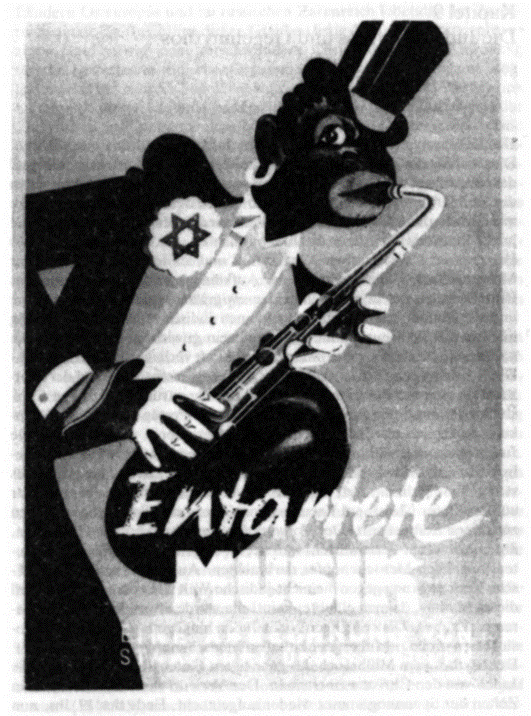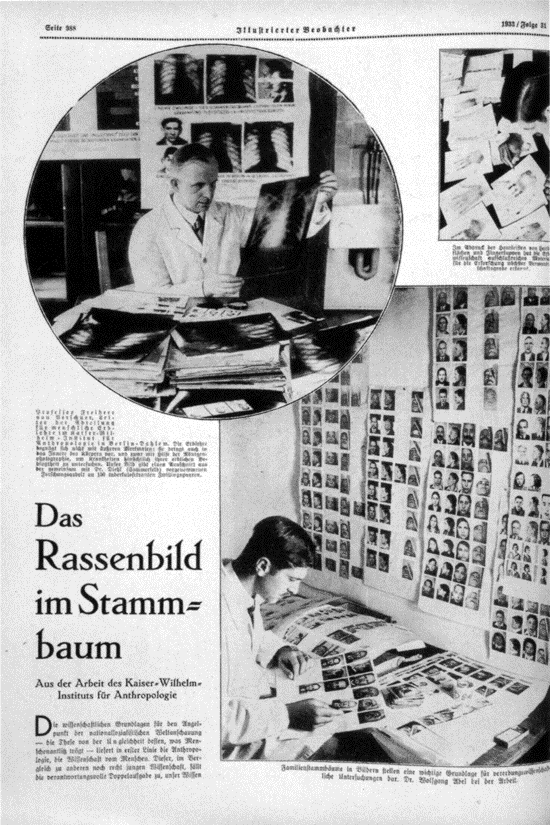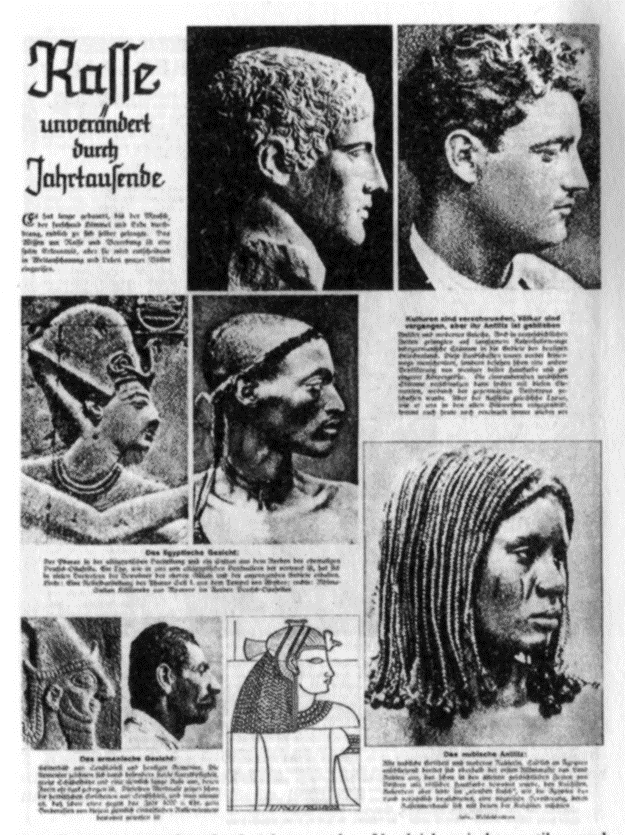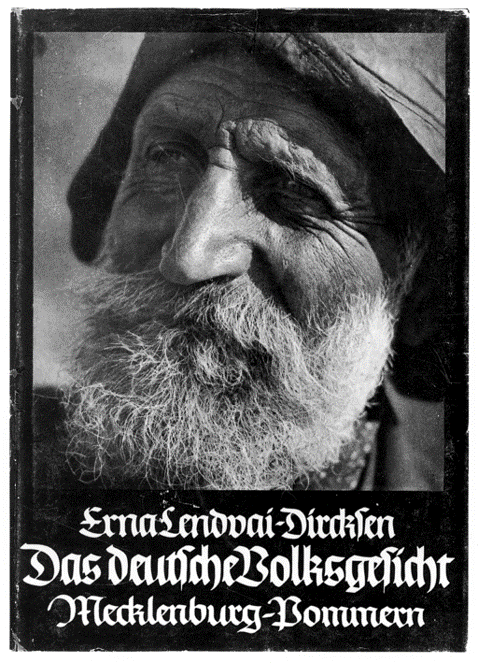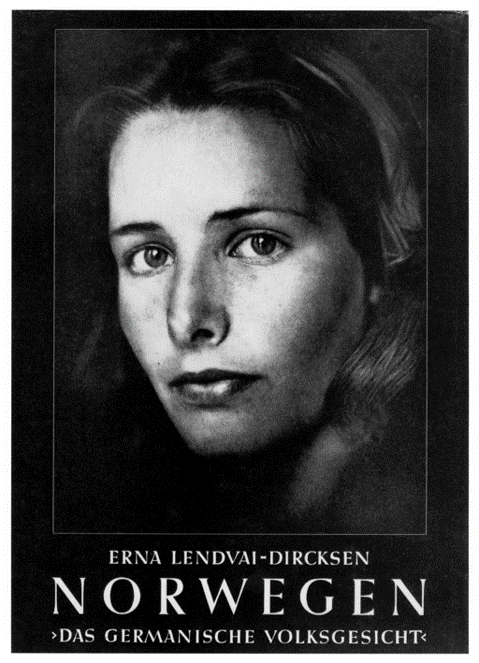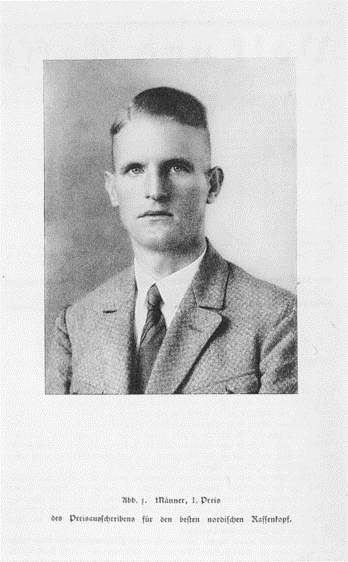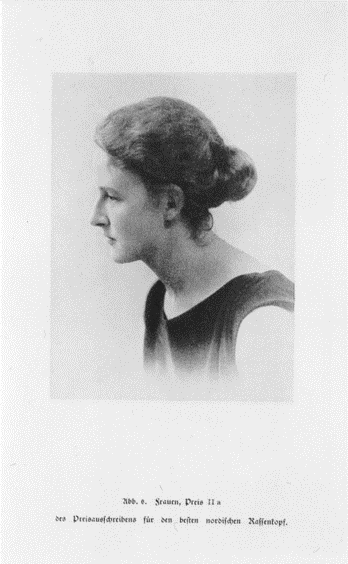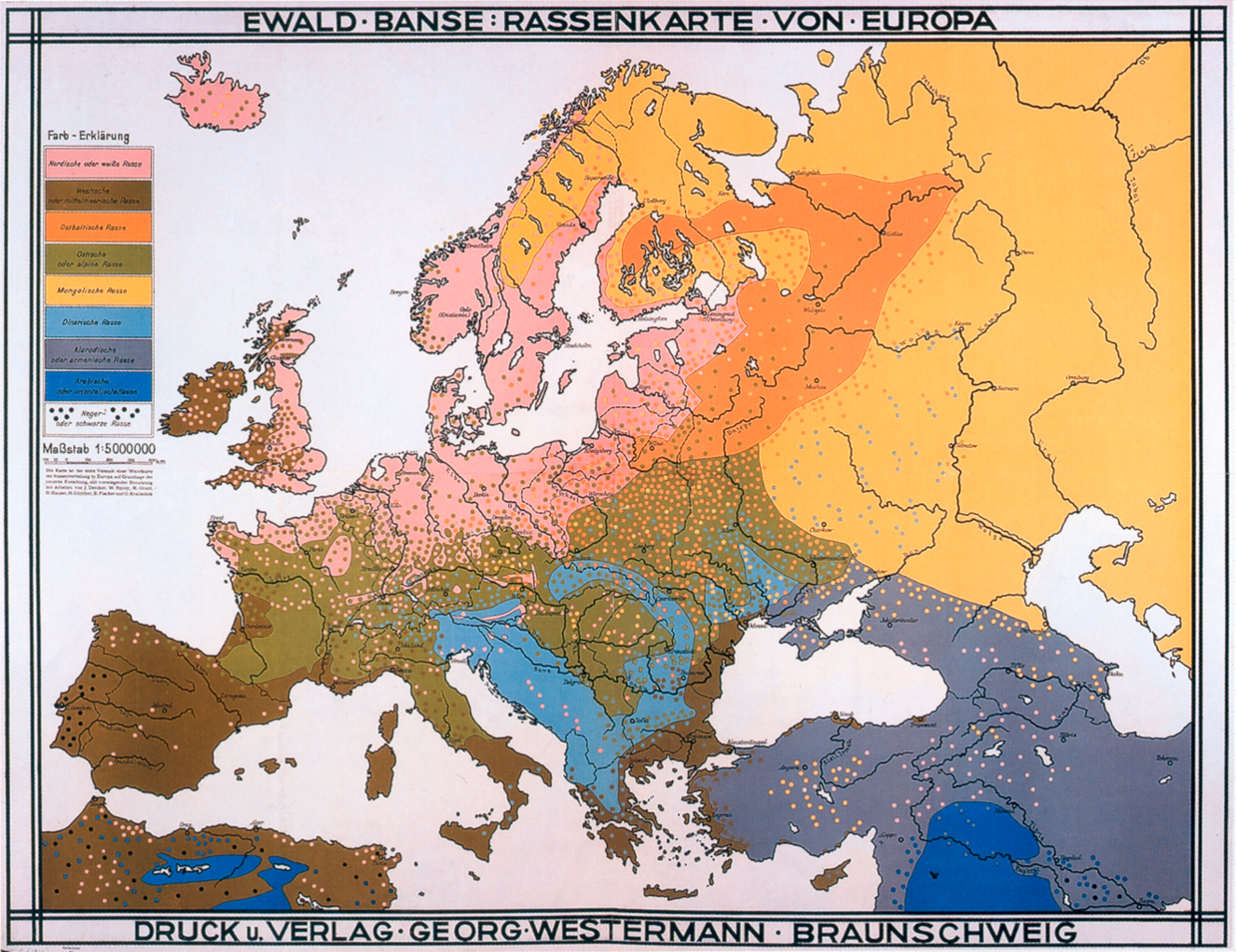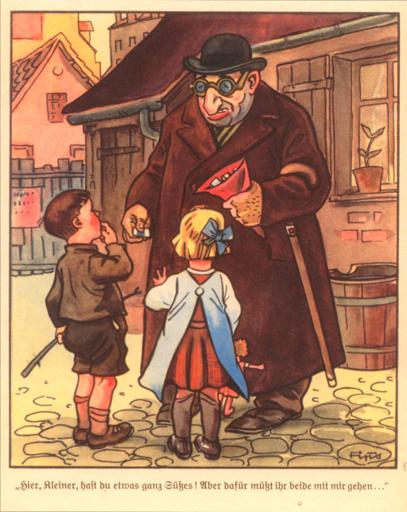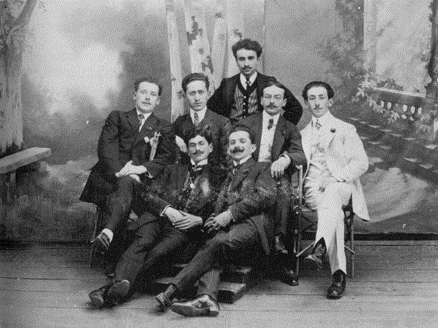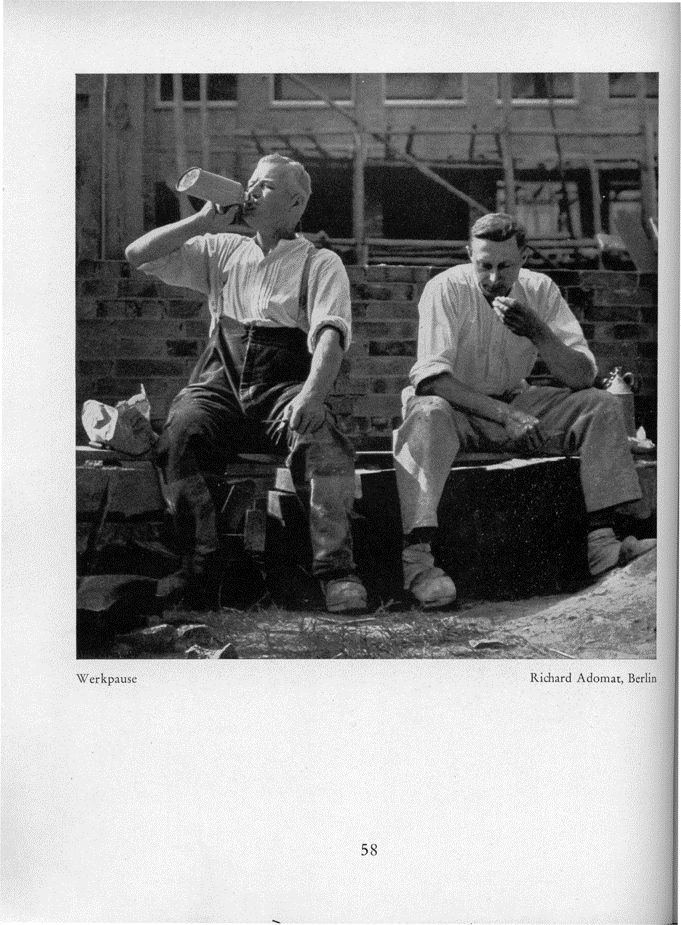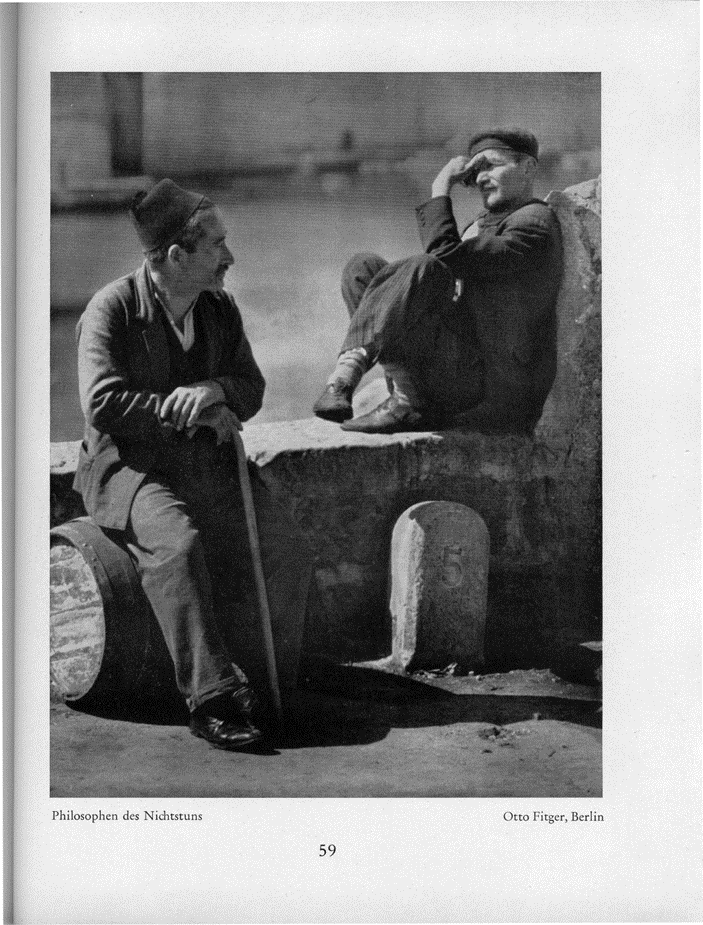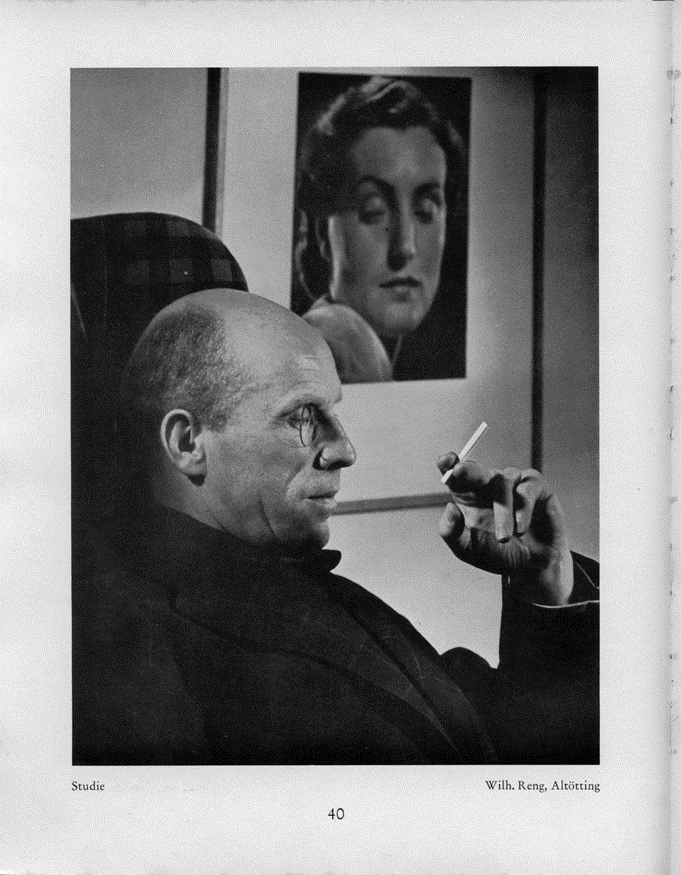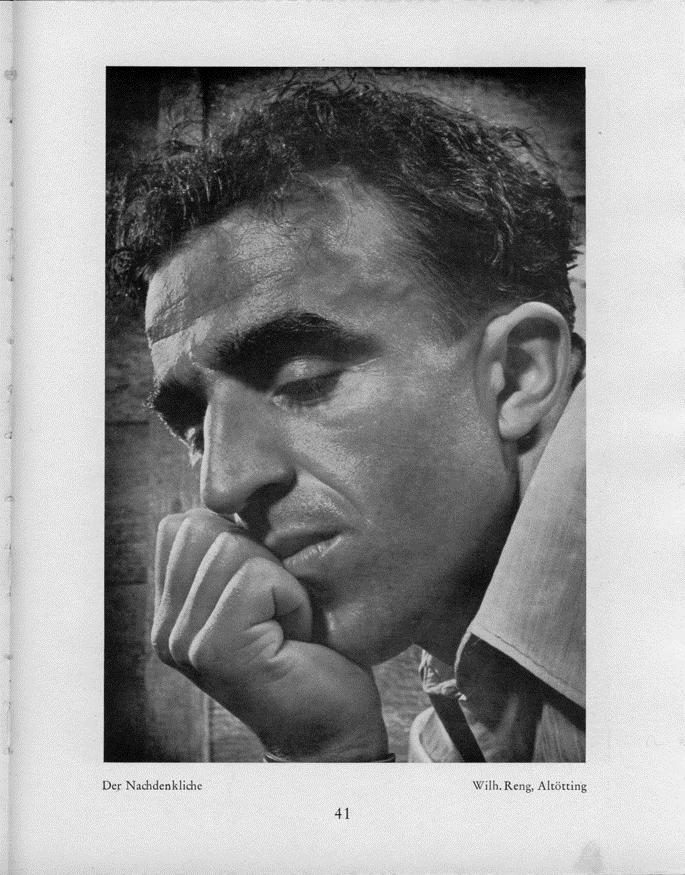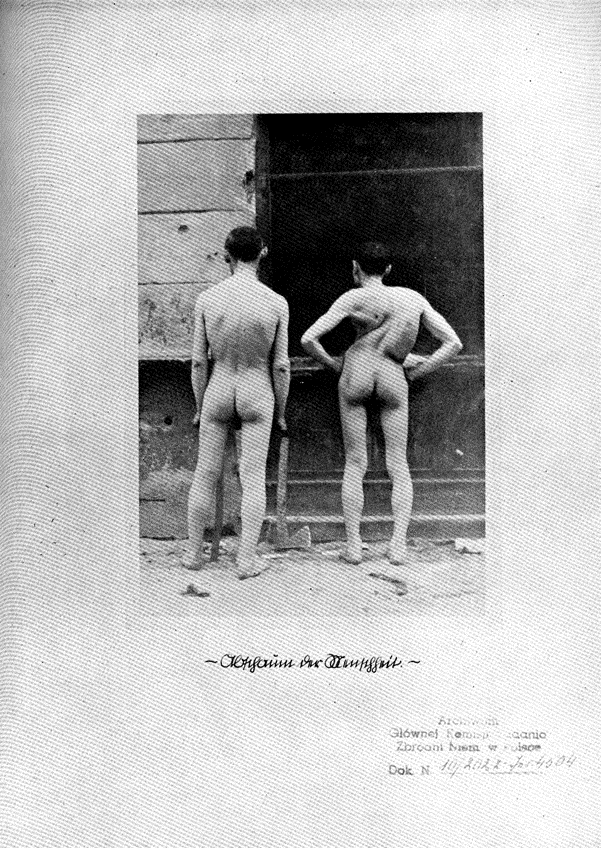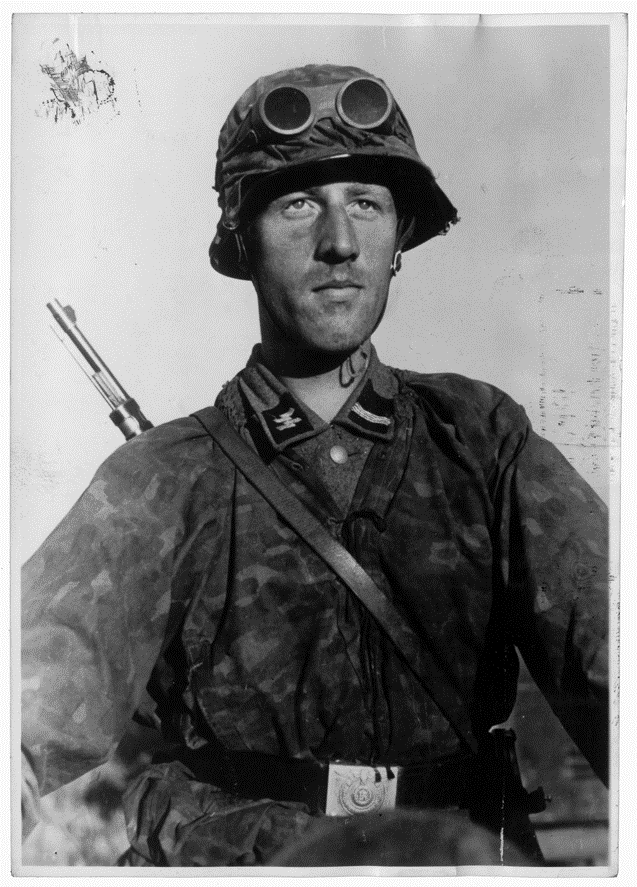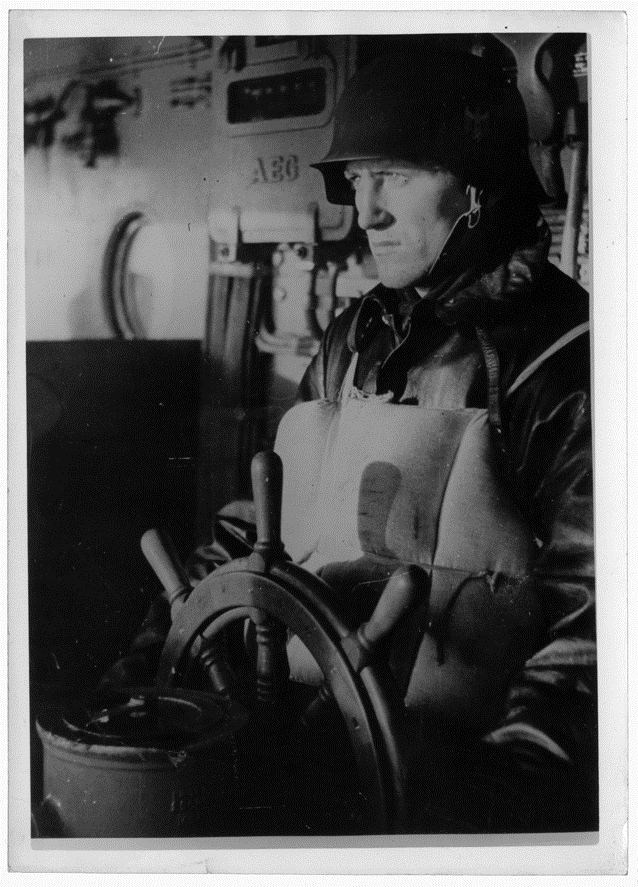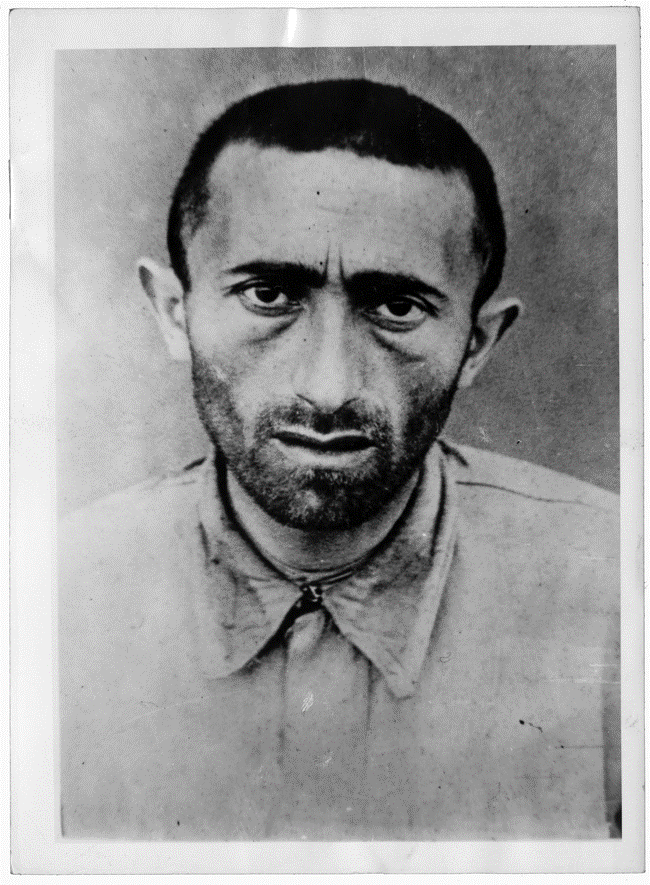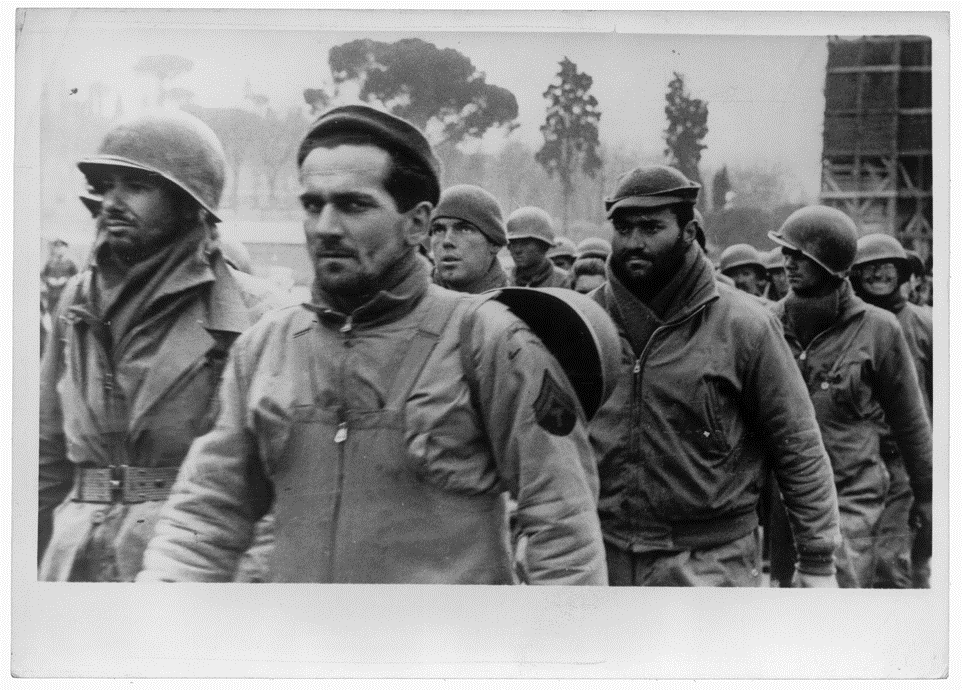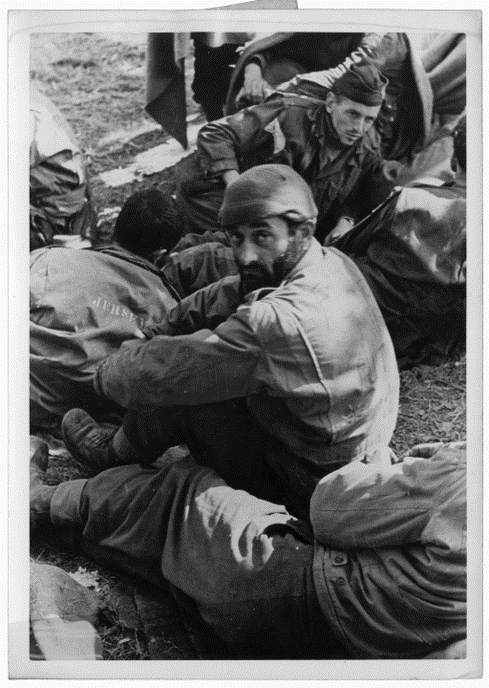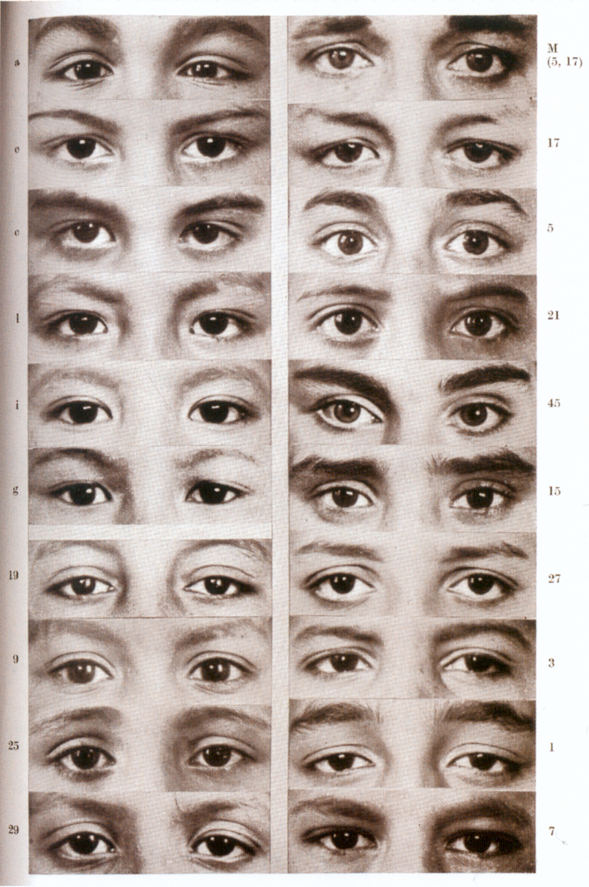Jahrgang 7, Nr. 2, Art. 1, ISSN 2363-6513, Dezember 2020
NS racism as a visual ideology
A presentation by Miriam Yegane Arani
Background: This presentation by Miriam Yegane Arani of an introductory iconographic analysis of National Socialist racism, provides a good entry point to Yegane’s basic research on sociological and photo-historical methodology of analyzing visual materials, in particular photographic sources, from the Nazi era. It is striking that the images published under the Nazi regime followed a certain program that polarized between idealized body norms and deviations from them. The Ministry of Propaganda presumably controlled the photo-publication to ensure that only photographs that conformed to the racial ideology were published. It can be assumed that under the Nazi regime there was an increasingly rigid polarization between the guiding and enemy images within the government-controlled image program. During the pre-war period, the focus seems to have been on propagating the “Nordic” model, whose visual counterpart is expressed in the “racially” pejorative enemy images of the war years. Particularly noticeable is the practice of distinguishing between people according to their outward appearance in pairs of pictures typical of the period, which were intended to illustrate “racial” antagonisms.
Tags: NS racism, National Socialism, propaganda, sociology of images
—
TIERAUTONOMIE, Jg. 7 (2020), Heft 2.
NS racism as a visual ideology
Contextual infos
The pagenumbers in the brackets all relate to: Miriam Y. Arani: Fotografische Selbst- und Fremdbilder von Deutschen und Polen im Reichsgau Wartheland 1939–45 (2008).
After 1945
Race-ideology did not disappear after 1945, partly because of personal continuities that were possible to remain in German society after the Second World War and partly because of the long-term effects this thinking-model had in the everyday conceptions of the vast majority. (426)
From a strictly scientific point of view, race theory had already longer been considered untenable. (426)
Soon after the Second World War, the physical anthropologist Juan Comas clarified on behalf of the newly founded UNO in a paper entitled “Race as a Myth”, that the National Socialist racial teachings were factually incorrect. Human heredity has nothing to do with the blood. (426) Furthermore, the findings of physical anthropology in no way lead to the conclusion that “racial purity” causes cultural development while “race mixture” would cause cultural decay. (427) The results of international anthropological, social and historical research allow much more to conclude that not it’s not different body shapes, skin colors, etc. that are causes of conflicts, but rather conflicts of interest between different social groups, through which visible variedness (body, clothing, religious customs etc.) first become significant as signs of difference. (427)
In particular in biology, the classification of human races is scientifically obsolete, since it’s not a suitable concept for describing the variability of Homo Sapiens. Human populations can’t be adequately classified with the category “race”. A correct biological classification as a “breed” [in German the term race and breed are the same: ‘Rasse’] is not even applicable to natural populations of animals, since an exclusive allocation to a single “race/breed” would be necessary, which is not possible in the case of humans. The only area in biology where “races/breeds” are spoken of now, is in the breeding procedures that affect domesticated nonhuman animals. Only in context with nonhuman animals domesticated by humans the ‘biologically correct’ zoological forms of “breeds” exists. (427)
Racism as a visual ideology
It is noticeable that the pictures published under the NS-regime are subject to a certain program that polarizes between idealized body norms and deviations from them.
The Ministry of Propaganda most likely controlled photojournalism to that effect, that only photographs were published that corresponded to the racial ideology. (430)
I suspect that under the NS regime there was an increasingly rigid polarization between the guiding- and enemy images of the government-controlled image program. During the pre-war period, the propagation of the “Nordic” model seems to be in the foreground, whose visual counterpart becomes expressed as the “racially” pejorative enemy images in the years of war.
Especially striking is the practice of differentiating between people according to their external appearance in pairs of pictures typical of the time, which sought to demonstrate a racial antagonism. To narrow down the high relevance of these “contrast images” more precisely it is helpful to remember that Adolf Hitler, in his time in Vienna became acquainted to the Ostara booklets of Adolf Lanz that contained a Christian religious racial doctrine which described a “racial conflict” between blond-blue-eyed “Ario-Heroicists” and dark “Sodom monkey-likes”. (408)
The NS-ideologist Alfred Rosenberg claimed that the creative power of Europe was to be traced back alone to the Germanic tribes and that their greatest threat were the “mudflows of Mongrel from Asia, Africa, the entire Mediterranean basin and its foothills”. (408)
The precursors of the NS race ideology
The racial ideology was not a new creation of the NSDAP, which merely brought together the already existing racisms in the human sciences and then put it with an incredible radicalism into practical politics. (381, 382)
Since the 18th century and throughout the 19th century, the people of the world have been classified by European anthropologists predominantly on the basis of external, visible characteristics such as skin color, body type, shape of skull, hair color and texture, eye shape, nose shape, etc. On the basis of visible characteristics scholars formed “race-types” and interpreted their outward appearances as signs of moral, emotional and intellectual qualities. (381f., 394)
In the 19th and early 20th century, scientific anthropology was for large parts racial anthropology. (395) At the end of the 19th century racial theory achieved the rank of a scientifically legitimized dogma, that tried to justify political domination with “scientific” arguments. European Scholars mainly used visible characteristics, which usually only change over a long-term (behavior patterns, clothing, traces of specific living conditions), as indicators for the construction of different “races”. (382) The characteristics ascribed to other races usually corresponded to the social prejudices of the involved researchers towards the foreign peoples. (382) The European anthropologists routinely ignored empirical facts in favor of the norms of their own socio-cultural milieu, and the characteristics attributed to the other “races” legitimized above all the claim to leadership of their own “white race”. (395)
Until the end of the 19th century, the racial anthropological model of order was based on a selection of externally visible characteristics (skin color, physique, shape of skull, etc.). With the beginnings of modern genetics at the turn of the 20th century the biological theories about humans detached themselves from the visible exterior. The visible appearance was now called “phenotype” and was attributed to the interaction of hereditary factors and environmental influences. The hereditary factors that are not directly perceptible were called “genotype”. This also meant that human-biological race theory became largely detached from the concrete appearance in favor of abstract considerations, that could no longer be traced by the general public. (395)
Since the middle of the 18th century, European scholars have classified and hierarchized humans as “races” within an anthropology that was understood in terms of natural history, and they interpreted the physical appearance of a person as an exterior indicator of certain mental and spiritual characteristics, which were considered to be hereditary and unchangeable. (391) “Race” became a political term of struggle in the context with the aristocratic counter-revolution at the end of the 18th century in the conflict of the “two races”, in which the “purity” of “race” was first used to serve as a basis of legitimacy for the aristocracy’s claim to power. (391)
Race theory had become an elite ideology already in the German Empire. (390) Around the beginning of the 20th century, race theory developed into the elite ideology of the German academic middle classes. Among their most important supporters were biologists, anthropologists and physicians. In the period between the wars, the number of the followers of ideas of “racial hygiene” (eugenics) increased. ( ) Race theory was a thinking model represented by renowned German scientists during the Nazi dictatorship, from which by no means all of them moved away after 1945. This is also related to the fact that this thinking model was also established in other Western societies. (426)
In the Nazi state, eugenic ideology was propagated as “hereditary and racial hygiene”. (430) In addition, the argumentation of racial ideology was connected with the theorems of the eugenic movement, bringing forth a fearsome horror scenario of the imminent extinction of the “nordic race”. (430)
Content of the NS race ideology
According to the NS racial ideology, based on their outward appearance people could be divided into “races”, which would bequeath not only physical characteristics to their descendants but also a “racial soul”. (380)
Within the Nazi racial ideology, it was assumed that there was a direct relationship between certain physical and psychological characteristics and that a person’s physical appearance could be used to draw conclusions about the individual’s soul and behavior. (381)
The racial theory referred not only to the visible body, but also to the visible behavior. (430)
The Nazi race ideology amounts to a complete biologization of the socially and culturally acquired characteristics of a human. Characteristic is the representation of social conflicts of interest as a violation of a “naturally given” social order. The biologistic view of humans negates the historical, cultural and social influences on human existence. (380)
Racial theory reduced the diversity of humans to a few, statically conceived “racial types”, so that very large numbers of people could be thought of as summarizable and international political conflicts could be rationally explained with supposed biological tendencies of the “races” involved. (382) “Races”, as an absolutized supra-individual structure, became the presumed subject of history (382).
The “Nordic race”
The Nazi dictatorship elevated the “Nordic race” to the physical and mental ideal for the entire German people. The characteristics ascribed to the “Nordic race” were propagated as exemplary: a slender and strong body, a long narrow skull, blond hair and blue eyes. The rosy-white skin was considered the lightest of all the “races” and therefore only it should be called “white”. (405)
According to Nazi race theory, the “German people” consisted of 6 races, whereby the “Nordic” portion was to be increased to 50% by “racial care”. For this purpose, the most valuable “racial” components were to be collected from the population and brought into dominant positions. (380)
Already at the beginning of the 20th century, parts of German society perceived Northern Europe as an untouched counter-world to the modernizing society in their own country. Northern Europe became a projection screen for a racial-biological utopia: the peoples of Northern Europe were declared “Germanic blood relatives” and “noble people”. (405)
The glorification of the “northern race” did not only refer to the physique type of a human being, but also to its allegedly directly connected “racial soul”. (406) The racial theorist Hans F. K. Günther described the following mental “leader-qualities” of the “northern race”: the “ability to judge, truthfulness and energy (‘Tatkraft’)” were outstanding. The “Nordic” human controls him/herself and shows “an objective, prudent attitude that often makes him appear cool and stiff”, his “sense of reality” in combination with his “energy” drives him to great undertakings. He unfolds “objective passion, while passionality (…) is far from him”. In social interaction he/she showed “little inclination to empathize with the nature of other people”. (406) Günther thus described a contemporary bourgeois German habitus and placed it in direct relation to a certain type of physique, which was judged to be exemplary. (407)
The equation of “Nordic” and “Aryan”
The Nazi ideology combined the visual idea of the “Nordic race” with the race-theoretical view of history in the tradition of Houston Stewart Chamberlain, which interpreted both the culture of Greek antiquity, which was regarded as exemplary by the German elites, as well as the “Aryans”, which had been suspected even longer ago, as “Nordic”.
Although the origins of the Aryan language are undoubtedly to be found in the Middle East, the term “Aryan” had already been a synonym for “Christian-German” since the imperial period and was explicitly limited to Nordic-Germanic racial types in the encyclopedias of the Nazi era. (407)
During the Nazi dictatorship, a distinction was made between superior and inferior human races and it was claimed that only “Nordic” people had intellectual and creative cultural potential. The other “human races” were more or less clearly denied a cultural capability. (380)
Hitler attributed the majority of progress in art and science to the “Aryans” as the only culturally creative race; he considered all other races to be uncultured and culturally destructive. Like the race-theoretical ‘pioneers’, he claimed that the culture-creating potency of the “Aryans” was threatened by “racial crossbreeding” and “blood mixing”, because this lead to degeneration and cultural disintegration. (407)
The NSDAP ideology explained more precisely that ancient Greece as a “Nordic” high culture had disintegrated due to the “racial mixture” between Greeks and Turks. (408)
Hitler believed that German “blood” must be kept “pure” because “blood mixing” would lead to a “lowering of the racial niveau”. (407)
Race mixture
In the middle of the 19th century, the French Count Arthur de Gobineau, in his essay “On the Inequality of the Races of Man”, took the view that people in the world were divisible into three main races and the “white Aryan race” was the crowning glory of creation. “Race mixture” would lead to cultural decay, because a “mixed race” was not capable of higher cultural achievements. He thought the “Germanic peoples” were the last “purely preserved branch” of the “Aryans” and threatened by “mixing” with foreign peoples. (391f.) The German Gobineau Society, founded by Richard Wagner, supplemented these assertions with the idea of being able to counter the supposed decline of the “Aryan race” by “breeding”. (392)
Following on from Gobineau, Houston Stewart Chamberlain claimed in “The Foundations of the 19th Century” (1899) that the “Aryans” were “pure-bred” cultural carriers and had been in a “racial struggle” with the “Jews” as a “mixed race” since antiquity. His racial-theoretical historical misrepresentation became widely effective in the German Empire, and Kaiser Wilhelm II made Chamberlain’s publication mandatory reading in the training of German senior teachers. (392) At this time, racial ideology was also a constitutive element of the German Emperor’s worldview. (392)
Finally, under the Nazi dictatorship, schoolchildren were taught that the culture of a people depended on its “race” and that German culture was in the tradition of the Germanic peoples, to whom the “Jews” were completely foreign in nature. (358)
The German-Germanic “People’s Face”
In the public visual world of the Nazi dictatorship – as in the associated politics – the focus of attention was not the individual, but rather the supposedly typical physical and psychological characteristics of large groups. (430)
Erna Lendvai-Dircksen’s books on the “German People’s Face” connected with the agrarian-romantic and anti-metropolis ideas, that became known under the slogan “blood and soil”, that were supported by the “völkischen” [Editor’s Note: a homogenous concept of “people” and “state” as an organic unity] groups of the Weimar Republic and the agricultural political apparatus of the NSDAP. Behind this was the idea of a social and biological unity of the Germans an based on a “piece of agrarian homeland” that was threatened by ”deracination”. (358)
Already in the last third of the 19th century, the “völkische” understanding of the German nation became the dominant ideology in the Prussian-dominated German Empire. (359)
The “völkischen” groups in the Weimar Republic also clung to the idea of a “racial hierarchy” associated with the “Volksgemeinschaft”-ideology [Editor’s Note:: unity of the ethnically homogenous ‘own’ people]. (379)
The “völkische” understanding of the German nation contradicts the democratic republican concept of nation, according to which “nation” is a political and “people” an ethnic category, so that from a democratic republican perspective a nation can also be composed of several peoples. (359)
The “average image” as a precursor of the “people’s face” (“Volksgesicht”)
The iconological roots of the German “people’s face” propagated in the Nazi era are to be found in the imperial era and the at that time still elitist racial anthropological-eugenic world of ideas. (430) Lendvai-Dircksen’s “people’s face” was preceded by the “average pictures”. (386)
The Prussian government established a non-democratic state in 1871 in the form of an empire. Now the elites involved in the rule “from above” made a supposed “essence” of the German people the nexus of national identity formation, and sought this in Christian, Aryan-Germanic and biological terms. (396)
Since the end of the 19th century, “illustrations” of a new way of thinking of the Western elites have been found in the form of “average pictures” or “composite photographs”. They were discussed within a transnational network of scholars around 1890-1920. What has come down to us is, among other things, an average image of Saxon soldiers, which belongs to the legacy of the first professor of photography at the TH Dresden (Robert Luther) at the beginning of the 20th century. He had received the picture from the art historian Georg Treu, who tried to prove that Classical Greek art had the purest ideal of beauty that was valid regardless of time and place. (385) For his research he also used average pictures, which he had become aware of through publications by Henry Pickering Bowditch of the Harvard Medical School. In the 1890s, Bowditch had been given with Saxon soldiers as photo objects by General von Funcke in Dresden. From numerous photographs of different individual heads, an average photo of the soldiers was finally produced by multiple exposures of these photographs on one and the same surface. (386) The average photograph of Saxon soldiers was to be compared with an “average face” of Slavic soldiers produced in the same way. Treu and Bowditch claimed that the “Germanic” head was rounder and the “Slavic” head was more angular. (386)
In the second half of the 19th century it became more common in Prussia to assume that the Germans were superior to the Poles. At the end of the 19th century, especially the Poles in Poznan became objects of an increasingly colonial self-image of the German Empire. (396) The continuing migration from divided Poland westwards into the German Empire and beyond became a political issue, which racial-theory-arguing-Germans portrayed as a “flooding” of the Germans by “the Slavs”. (398) The German Empire strived for an imperial world status and pursued a colonial policy both internally and externally. (399) The polarization between “Germans” and “Slavs” that began in anti-Polish journalism during the imperial era was a mental abstraction and imagination that did not do justice to the political realities on the ground. The “average photographs” of Saxon and Wendish soldiers were not only a synthesis of “scientific” images of humans with aesthetic values. They also represent an abstracting pictorial conception of the imperial elites of their “people” in a racial-ideological-eugenic context. (402)
The inventor of the average picture method was Sir Francis Galton, who also came up with the hypothesis, adopted by the previously mentioned two, that average pictures would lead to conclusions about the nationality, the “race” and the intelligence of the group in question. (386)
Galton is considered the founder of “eugenics”. He wanted to use quantitative methods to create the basis for the social selection of people in order to improve the quality of the “British race”. With his publications on the heredity of intelligence and talent, he laid the scientific foundations for a concept for the “ennoblement” of society, which he called eugenics from 1883 onwards: the allegedly too high birth rates of the weak, sick and poor were to be reduced and the allegedly too low birth rates of the intelligent, healthy and rich were to be increased. (386f.) Eugenics gained in importance above all because of the new, “biological” perspective on human beings. (387) It completed the arsenal of arguments put forward by the Social Darwinists who sought to apply Darwin’s theory of evolution to social life and who held the view that human beings were biologically determined to occupy certain positions in society. (387) Towards the end of the 19th century the eugenic movement also established itself among the economic and political elites of the German Empire and was institutionalized at German universities under the term of “racial hygiene”. (390)
The defining power of a minority of scientists became an instrument of power to control a majority. (388)
Visual enemy images
Physiognomics provided in particular explanations for the internal structure of the Germans, who were outwardly quite different. (361) Race theory, on the other hand, served primarily to scientifically rationalize the exclusion and devaluation of “Jews” and “foreigners” („Fremdvölkischen”). (361)
Enemy images of “the degenerated”
Since Darwin’s theory of evolution, the line between “human” and “nonhuman animal” seemed to become more fluid. European racial anthropologists took up this idea, arguing that the non-European “races” had not yet completed the process of becoming human and that Europeans too could “degenerate” and sink back to “animal” life forms. The “mentally ill” were now settled at a level of development between ‘humans’ and ‘animals’. (387f.)
The National Socialist “hereditary and racial hygiene” amounted to a breeding concept affecting German society. Initially, “hereditary patients” (“erbkrank”), “asocial” and “Jews” were to be excluded. The corresponding laws to legalize state exclusion measures were passed in the mid-1930s (Law against Habitual Criminals 1934, Inheritance Health Law 1935, Blood Protection Law/Nuremberg Laws 1935). (428)
During the Nazi dictatorship, the process of visual exclusion even became part of the state health care system. In the context of state-“hereditary and racial care”, the “foreign” and “sick” were excluded by aesthetic taste judgements in the guise of medical expertise. “Aryanised” German doctors judged the people entrusted to them in relation to a model of the “inherited healthy” (“erbgesunden”), supra-individual German “people’s body” (“Volkskörper”) with a “Nordic race ideal”. In the medical field, the aesthetic taste judgement about the body of a person became a medical judgement about the “racial” inheritance-value (“Erbwert”) of a person for the “people’s body” (“Volkskörper”) and a right to life based solely on this. (409) These processes are also reflected in visual communication: under the Nazi regime, visual representations of “abnormal” or “degenerated” human bodies were repeatedly used to evoke fear, disgust and contempt in viewers. The “abnormal” body was considered a sign of a “sick” mind. (409)
The iconography of the “abnormal” human being, popularized under the Nazi regime, was in line with the view held by the Italian doctor Cesare Lombroso as early as 1876 that there were “born criminals” who differed from other people in their physical build. His student Hans Kurella declared in 1893 that people “born to crime” had typical physical characteristics: a skull that was too small or too large, thick and dark hair, an asymmetrical face, deformed ears, large and wide or long and thin noses. (409)
Under the Nazi regime, aesthetic taste judgement, “racial hygiene” and criminal anthropology merged seamlessly. (409) Accordingly, the prisoners of Dachau concentration camp were presented in the NSDAP party magazine “Illustrierter Beobachter” as “deformities” (“Missgestalten”) with deep-set eyes, hollow cheeks, crooked mouths, protruding ears, scars etc. (410).
Enemy images of “foreign peoples” and “foreign races”
Of significance for the intended iconography of the “völkische” portrait photography is the exclusion of “un-German” physiognomies, which was also intended by the manufacturer. (364) In 1933 Erna Lendvai-Dircksen expressly advocated the exclusion of aesthetic figures of “foreign style” from the German pictorial world, because this would “not allow a national community”.
Images of the enemy / Jews
The government-controlled visual self-image of the Germans under the Nazi regime is primarily revealed in relation to the visually expressed image of the enemy “Jew”. During the Second World War, Nazi press propaganda used Jews as a central enemy image, with which other enemy images were associated. For example, anti-Polish Nazi propaganda was repeatedly closely linked with anti-Semitic propaganda. (384)
Enemy images / Polish
In order to understand the visual representation of the Poles in the National Socialist imagery of the Second World War, it is useful to be aware that at the beginning of the Second World War the mental border between Europe and Asia was moved by the Nazi regime to the western border of the Soviet Union – and thus ran through the previously Polish territory. (420)
“Racial science” (“Rassenkunde”)
In the Nazi state, racial research scientifically underpinned the ideology and policies of the NSDAP. The Polish civilian population also became the subject of German-language race research. (420)
In the Reichsgau Wartheland in particular, a professionalising and radicalising centre of racial selection of people was established. Experts of the SS on race and folklore tried to put their “folklore” political (“volkstumspolitischen”) measures on a scientific basis, in cooperation with the German civil administration and the Reichs-University of Poznan. (422f.) With the introduction of the DVL-procedure (Deutsche Volksliste) in all “incorporated eastern territories” in 1941, a “racial patterning” of the inhabitants in accordance with the SS’s RuSHA (SS Race and Settlement Main Office) was enforced in the Warthegau, which was also applied in other German-occupied territories in Eastern Europe and came to a provisional conclusion in the Warthegau in 1943. (426) The anthropologists Egon von Eickstedt and Ilse Schwidetzky used “racial formulae” to calculate allegedly exact percentages of “racial proportions” of individuals in the incorporated eastern territories. (420f.)
At the “Reichs-University of Poznan”, application-oriented race research was conducted for the Nazi dictatorship. Here, for example, the “Völkerpsychologe” Rudolf Hippius and the biologist Konrad Lorenz carried out race-relevant studies on the civilian population in cooperation with SS functionaries. This included, in particular, “Mischlingsforschung” (“mixed-race-research”) as a special branch of research which would have had no right to exist without the race ideology. In 1942, Rudolf Hippius carried out a psychological study of German-Polish “half-breeds” in order to prove that the degree of “racial mixing” had an effect on the psychological structure of a person. He assumed that Germans and Poles had fundamentally different personality structures and that German rule over Poland was legitimate because they were only prepared to “use their forces regularly and in an orderly manner” under duress. He came to the easily predictable conclusion that “racial mixing” between Germans and Poles would lead to “character disharmonisation”. (421, 422)
Heinrich Himmler believed that “Nordic” children were more creative than “racial mongrels” and that the Poles had only joined Europe through “Nordic” Germans. He fantasized that “inferior foreign host peoples” such as the Poles would want to drain “Nordic blood” from the Germans, because all cultural and state-forming achievements would go back to the “Nordic race”. (421)
National Socialist racism as a visual ideology; picture panels
Table of nations, middle 18th century.
The term “racism” describes a specific relation of social oppression and violence in which the ruling groups differentiate a very large number of people according to physical and cultural characteristics. Allegedly typical character and behavioral traits are attributed to them, which imply an alleged “natural” hierarchy of people. The “racial” attributions of characteristics serve to justify unequal treatment of people in economic and political life.
From: Eugen Fischer, Grundlagen der Humangenetik und Rassenhygiene (1921/1923).
With regard to National Socialist racism in particular, there are certain communication problems due to the different perspectives on the facts. For most Germans under Nazi rule, racial ideology seemed to be insignificant, as people were not consciously aware of the resulting unequal treatment. From their perspective, the theory and practice of Nazi racial ideology seemed to diverge widely. Accordingly, a German whisper joke of the time said: “What does the ideal German look like? Blond like Hitler, tall like Goebbels, slim like Göring (…)”. The racial ideology in the Nazi state before the Second World War affected mainly minorities and marginal groups in German society. With the beginning of the war, however, racial ideology became more relevant for numerous people in German-occupied foreign countries, who were now declared “racially” inferior by the Nazi state. In occupied Poland in particular, it became apparent that it was directed not only against the Jewish minority but also against the Christian majority of the population. The racial ideology was of central importance for the moral legitimization of the NS crimes of murder against millions of people and formed the ideological core of the National Socialist policy of extermination.
Hitler Youth learning the definitions of “full Jew”, “half Jew” and “quarter Jew” (Nuremberg Laws), 1938.
Racial studies for school assistants, 1943.
[Plates 3, 4; Heredity and Racial Studies].
The concept of “race” is one of the core elements of Nazi ideology and was propagated linguistically, primarily in the guise of a scientific theory of heredity. In addition, the race ideology was also visually popularized to a considerable extent during the Nazi dictatorship. During this period, masses of widespread pictorial representations of so-called Nordic people and their supposed enemies, scientific racial anthropology and the “völkisch” utopia of a “racially pure” German nation merged into one another. The historian George Mosse described racism as a “visual ideology” and saw visuality in particular as one of its greatest strengths. However, the specifics of this visual ideology have not yet been sufficiently researched in relation to National Socialism.
Cover of the magazine “Neues Volk” with “Nordic” ideal types, 1938.
Poster of the exhibition “The Eternal Jew”, which was shown in several German cities in 1937/38.
[Plates 5, 6; “New People” and “The Eternal Jew”]
The Germans under the Nazi regime were educated in educational institutions and through the mass media controlled by the Ministry of Propaganda to a folkish-racial vision standard. They were to view their own nation in a “racial” way. They were continuously given a conventionalized visual idea of what Germans should look like by the government and the feeling that they should stay away from “foreign”, supposedly inferior “blood”.
Touring exhibition “Degenerate Art” (“Entartete Kunst”) – defamation of modern art with racist slogans.
Cover of the publication “Entartete Musik” 1938 on the occasion of the eponymous exhibition against “the penetration of brutal jazz rhythms into the German world of music”.
[Plates 7, 8; “degeneration” through “niggering” (“Verniggerung”)]
By means of Nazi pictorial propaganda and racial education, in which the use of pictorial material was common, an emotionally guided distinction between “Germans” and “foreigners” (“Fremdvölkischen”) was practiced, which further spread and consolidated the Nazi racial ideology.
From: Illustrierter Beobachter, July 1933, showing the scientists of the Kaiser Wilhelm Institute Otmar von Verschuer (above) and Wolfgang Abel (below). [The title says: “The racial image in the family tree”.]
From: Märkischer Adler, 7 June 1936, comparison of antique and contemporary heads. At the top: Equating Augustus with the “Nordic race”. [The title says: “Race, unchanged throughout centuries”]
[Plates 9, 10; “Racial studies in the press”]
Looking at other people was broadly coupled with a process of distinguishing between “own” and “foreign” physiognomies, between norm and deviation, good and bad. The processes of exclusion initiated at the visual level related to easily recognizable external characteristics such as physical appearance, clothing and behaviour. On the basis of published photographs, aesthetic taste judgements about people of different cultural backgrounds were practiced, which were transferred to the social interaction with real people.
I would like to try to illustrate the self-image of the Germans propagated under National Socialism by means of Erna Lendvai-Dircksen’s “völkischen” portrait photographs. The photographer achieved a relatively high level of recognition under the Nazi regime through her photo albums on the “German” or also the “Germanic folk face” (“germanischen Volksgesicht”).
Erna Lendvai-Dircksen, photographs from the years 1933-1945.
[Plates 11, 12, 13; Lendvai-Dircksen]
Her “völkischen” portrait photographs have also been published since the 1930s in large mass magazines and racial-political journals in hundreds of thousands of copies. Lendvai-Dircksen’s portrait photographs usually follow a consistent concept: they show close-ups of faces, with all socio-cultural contextual information about the person in question being blanked out. Her photographic models were usually German farmers, initially older ones with faces marked by wind and weather, later younger ones with smoother faces. The photographer depicted the faces of the individual people like light, rigid masks against a dark background. Often they are photographed from a slight view from below, so that they appear slightly raised to the viewer. With her subject matter and stylistic features of the picture design, which were intended to remind of old German and folkloric-realistic paintings, the photographer underpinned the idea of a centuries-long “German” community of descent. Lendvai-Dircksen’s illustrated books, in which she summarized these portraits, served to illustrate a biologically and socio-culturally homogenous German or Germanic “Volkskörper”. The faces she presented met widespread ideas of the appearance of the Germans. At the same time, they were consistent with the National Socialist ideas of the “Nordic race”.
Winner of the competition for the best Nordic breed head of the magazine “Volk und Rasse” (1926).
[Plates 14, 15, 16, 17; winner of the competition for “Nordic heads”]
Lendvai-Dircksen’s portraits of German farmers and Nordic people [plates 11, 12, 13] corresponded to the preferences of the “völkischen” groups and the romantic agricultural and anti-government “blood and soil” ideology of the Weimar Republic. Under the Nazi dictatorship, the term “völkisch” denoted a “racially” understood national feeling, according to which Germans were a “blood and ‘species’ community” (“Bluts- und Artengemeinschaft”).
Lendvai-Dircksen’s photographs and illustrated books [plates 11, 12, 13] gave the public an aesthetic model of what a “German” physiognomy looks like and a visual sense of the so-called “German way”. According to the Physiognomy of the Zurich vicar Lavater, the head and face were the external expression of a person’s soul and morality. This idea from the 18th century was increasingly combined with the search for anthropological types in the 19th century. At the beginning of the 20th century, therefore, pictorial representations of individual people often did not have the purpose of showing a particular individual, but were intended to represent an anthropological type. This led to the endeavor to identify a specifically “German” type of person. Erna Lendvai-Dircksen stylised a non-representative selection of German faces in the “völkisch” sense into a superordinate, de-individualised “folk face” (“Volksgesicht”). She illustrated physiognomies in the sense of a community that extended beyond Germany into northern Europe.
Legend of the race map (1925): pink “Nordic or white race”, brown “Westic or Mediterranean race”, orange: “Eastern Baltic race”, olive green “Ostic race”, yellow “Mongolian race”, light blue “Dinaric race”, violet “Armenian race”, dark blue “Arab or Oriental race”, at the bottom “Negro or Black race”.
[Picture plate 18; “race map” (“Rassenkarte”)]
The Nazi state saw itself as a “völkischer” state, whose basis was to be a “social unit” founded “in blood”. Hitler wrote in “Mein Kampf” that the “völkische Weltanschauung”, the “völkische” worldview, denied the equality of people and assumed the existence of higher and inferior human “races”. He interpreted world history as a “racial struggle”.
At that time, people with the same physical and psychological characteristics were considered a “race”. In the tradition of European racial anthropology and against the background of Gobineau’s and Chamberlain’s racial theories, the outward appearance of a “race” was directly inferred from a supposedly “racially” conditioned mental and spiritual state and a certain cultural status. The National Socialists elevated the so-called “Nordic race” to the physical and mental ideal for the entire German people. In the tradition of the racial theoreticians, the so-called “northern race”, the “Germanic” and the “Aryans” were equated, because the Germans, and before them the Germanic people, were said to have preserved the “blood” of the “Aryans” in the purest possible way.
Adolf Hitler: “The ‘völkische Staat’ must place race at the center of general life” …
Information- and Worksheets for ‘Reichskunde’, Magdeburg 1941.
[Plates 19, 20; worksheets on “racial studies”, Hitler quote: ethnic national state – race]
Information- and Worksheets for ‘Reichskunde’, Magdeburg 1941.
[Plates 19, 20; worksheets on “racial studies”, Hitler quote: ethnic national state – race]
German children in the Nazi state were taught “racial studies” (“Rassenkunde”) from adolescence onwards, and the use of visual material was common practice. I show two pages here from the “Merk- und Arbeitsblätter für Reichskunde” (Information- and Worksheets for Reichs-Studies) from 1941, which were aimed at young vocational school pupils. Why lessons in racial studies were given is clear from the Hitler quotation in the first line: “The entire educational work of the ‘völkische’ state must find its crowning glory in the fact that it burns the sense of race and racial feeling instinctively and rationally into the heart and brain of the youth entrusted to it.”
The text of the worksheet stated that all European peoples would be made up of six races, with the proportions of “races” varying in each case. Peoples would be always made up of several “races”, with one or two “races” leading the way. In the case of the German people, the “Nordic” and “Faelic” (fälische”) races would be dominant and decisive. The proportion of “Nordic” people would be higher among the Germans than among other peoples: 10% of Germans were “pure Nordic” and the majority of Germans had “Nordic blood”.
A table on the worksheet is to represent the six European “races”. Each one of the so-called “races” is assigned a portrait. In the following rows of the table you find information on the physical appearance of the “races”. Remarkably, only the skin of the “Nordic” and the “Faelic race” is described as light and rosy and the eye colors as “blue to grey”. All other “races” are described as more colorless or darker. The worksheet contains no information about the alleged “mental characteristics” of these alleged “races”. However, they can be found, for example, in Hans F.K. Günther and a devaluation of all non-“Nordic” and “non-Faelic breeds”. The text for the pupils is limited to the statement that in Germany “pure-bred” representatives of other European breeds were rare.
The authors emphasize that people of the “Nordic race” have excellent qualities and are therefore particularly promoted by the Nazi state. They were “gifted with imagination”, had a “sharp mind”, had a “sense of responsibility” and were “born to be leaders”. They had a “matter-of-fact and sober view”, a “good organizational talent”, “drive to action” and “creative urge”. In conclusion, the authors emphasize that it is not only physical appearance that is decisive for the assessment of a person, but also the “attitude” and “sort of display of oneself”, which would indicate the “racial soul”. Thus, even a person who looks “Ostic” (“ostisch”) could be “Nordic” in thought and action.
This restriction was necessary in order to be able to relativize the appearance of the Nazi top officials by referring to their “racial soul”. At the same time, however, the relativization of the visible appearance of a “race” also meant the opening of infinite discretionary scope for the so-called race experts of the Nazi regime. For the assessment of the relevance of the visible exterior of a human being was ultimately withheld from these racial experts in individual cases, which the “völkisch” state produced. For in the case of people discriminated against and persecuted by the Nazi regime, the racial argumentation modules were used specifically against those affected. For example, Poles could look “Nordic”, but in cases of doubt, the “racial soul” attributed to them was always considered “foreign”.
Another worksheet presents “The three race circles” and is introduced with the Hitler quote: “The völkische state must place race at the center of general life.” The text that follows explains that the people of the earth could be divided into three “race circles” “purely outwardly”: “whites, yellows and blacks”. The subgroups of these “racial circles” would be called “races”. A “race” would be a group whose members display a large number of the same physical and mental characteristics that were equally present in their descendants.
The three “race circles” are presented in tabular form for comparison. They are distinguished according to the criteria: “important representatives of the race circle”, “physical characteristics” and “mental characteristics”. In the line “important representatives” the faces of a “White”, a “Yellow” and a “Black” are shown. The “White” is represented by a young man in a white shirt, tie and suit jacket; he looks – photographed from a slightly lower perspective – beyond the viewer into the distance. The “Yellow”, on the other hand, is depicted as a male child in nature-loving and poor-looking clothes, looking past the viewer at the side of the picture. The “Black” is presented as an adult man without clothing. His head is photographed from above, so that it appears that the man is looking up at the viewer. In the next lines the “race” subordinated to the “race circles” and their “residential areas” are listed: The “white race circle” is assigned the supposed six European “races”, the “yellow race circle” is assigned the Chinese and Japanese, Lapps, Eskimos and Indians, as well as Turks, Arabs and Iranians. The “black race circle” includes Africans and Afro-Americans, Australian natives and South Sea Islanders.
In the line on “physical characteristics”, there is surprisingly little information on the “white race circle”, which is only described as “fair-skinned”, and relatively much information on the other “race circles”. However, these only mention characteristics of individual sub-groups, which are then transferred to the entire “race circle”. Accordingly, “the Yellow” have a yellow to reddish skin color, a flat, broad face, “slit eyes”, a stocky figure and “short limbs”. According to this, “Blacks” have a “broad, flat nose”, “bulging lips”, curly hair, a “slender figure” and “long limbs”. The implied hierarchy of the “racial circles” among themselves is mainly based on the “mental characteristics” attributed to them. The “Whites” would be “spiritually” leading, “cultural creators” and “state-forming”; the “Yellows” were “empathetic”, “stuck on old cultural levels” but receptive, and the “Blacks” were “little capable of development” and had “low intellectual abilities”.
After confrontation with this table, students should apply what they have learned in an exercise and draw the distribution areas of the three “race circles” on a small map of the world. Those who do this will inevitably get the impression that the “yellow ones” pose a threat to the “white ones” because of their spatial extension and developmental capacity.
Anti-Semitic graphics in “Stürmer” style.
Jews in Poland, before 1939.
[Plates 21, 22, 23, 24; NS graphics “Jews” and photos of Polish Jews before 1939].
The doctrine of race offered a pattern of interpretation of apparently great explanatory power, as it provided a key of interpretation for the different manifestations of people in the world. Interestingly, the two sheets just presented do not contain any statements about Jews, who during the Nazi dictatorship were often classified “racially” as “Middle Eastern” types, although they had lived in Europe since Roman times at the latest. One reason for this is that the National Socialists propagated the principle of “racial purity” (“Rassereinheit”) and stylized Jews into a counter-principle of “racial mixing” (“Rassenmischung”). This figure of thought was not new, but already pre-formulated by Houston Stewart Chamberlain. On the visual level, the Nazi state produced various enemy images of Jews, some of which propagated the supposedly “Middle Eastern” (“vorderasiatisch-orientalische”) appearance, others the danger of “racial mixing” and others anti-Semitic fantasies. In addition to the very striking images of the enemy, relatively subtle photopublicistic depictions were also created, whose contemporary anti-Semitic significance is difficult to recognize for today’s viewers without knowledge of Nazi racial theory.
Photofreund-Yearbook 1939: “Work Break” (“Werkpause”).
Photofreund-Yearbook 1939: “Philosophers of doing nothing” (“Philosophen des Nichtstuns”).
[Plates 25, 26; picture pair “Photofreund” 1939]
An example of this are pairs of pictures consisting of an “Aryan” and a “Semitic” page, which appeared repeatedly in the yearbooks of the magazine “Photofreund” at that time.
As a generalization of the racial ideological Nazi image propaganda, it can be said that it linked an aesthetic judgement of taste about the appearance and visible behaviour of people very closely to political meanings.
Photofreund-Jahrbuch 1942: “Study” (“Studie”).
Photofreund-Yearbook 1942: “The Thoughtful One” (“Der Nachdenkliche”).
[Plates 27, 28; picture pair “Photofreund” 1942]
The conformity of a person’s appearance and behaviour with the “Nordic” racial ideal was considered “beautiful”, whereas the deviation from this ideal was considered “ugly”. All physique types and mental impulses considered “foreign” were to be intuitively and emotionally excluded by the German “Volksgenossen”. Under the Nazi dictatorship, the so-called “instinctive” recognition of the “foreign folk” (“des Fremdvölkischen”) was regarded as proof of the so-called “healthy folk soul” (“gesunde Volksseele”). The process of social exclusion under the Nazi regime, which was initiated on the basis of aesthetic taste judgements about the visual appearance of a person, can also be partially proven existent in the scientific-medical field. The biologist Konrad Lorenz, for example, wrote in 1940 that the so-called “species-specific (‘arteigene’) perception of beauty and ugliness” allows a correct distinction between valuable forms of life and so-called “degenerative mutations”. The term “degeneration” leads into the field of eugenics, which unfortunately cannot be dealt with further here for reasons of time. Eugenics, like racial ideology, attributed all violations of the normative concepts of the ruling elites to supposed biological deficiencies of the ruled, which were regarded as hereditary and unchangeable. Also in the context of National Socialist “hereditary and racial hygiene”, “the sick” and “the foreign” were excluded by aesthetic taste judgments in the guise of medical expertise. The overlap between the eugenic and racist dimensions of National Socialism is also reflected in the pictorial world.
Press photo of the propaganda companies of the German Wehrmacht, 14.8.1941. Caption: “The Soviets used such criminal types to fight German soldiers.”
“Scum of humanity” (“Abschaum der Menschheit”). Page from the report by Jürgen Stroop on the suppression of the 1943 uprising in the Warsaw Ghetto.
[Plates 29, 30; Soviet war prisoner of war / Hähle, and “degenerated” Jewish bodies / Stroop].
Under the Nazi regime, visual representations of “abnormal”” or “degenerated” human bodies were repeatedly used to evoke fear, disgust and contempt in the viewers.
The propagandistic success of the dissemination of the Nazi racial ideology is partly due to the fact that it was an elite ideology that was already widespread among many German and “Western” academics before 1933. The widespread effect of the racial ideology is – apart from the aforementioned school indoctrination of German youths – very probably due to the aggressive image propaganda of the Nazi regime. In the 1930s, the number of photographs published in newspapers, magazines and books increased in Germany.
Press photo of the SS propaganda company (“SS-Propagandakompanie”) of the German Wehrmacht, no date, caption: “On the Soviet front. The gaze of this Kradmelder, a young Dane who fights as a volunteer in the Waffen SS on the Eastern Front, is clear and certain.”
Press photo of the propaganda companies of the German Wehrmacht, 7.6.1944, caption: “The battle rudder man has a very important function to fulfil on the ship. He cannot and must not leave his place during an attack. (…).“
[Plates 31, 32; press photos of “Nordic” soldiers]
While the Germans and their supposed “Artverwandten” were stylized in the visual mass media of the Nazi state towards the so-called “North-Racial” (“nordrassischen”) ideal, Jews and Soviet Russians in particular were presented as unhuman-like enemies who seemed to be standing on a lower level of cultural development. The Germans, on the other hand, were portrayed in the photojournalism of the Nazi state as “sympathetic” as possible in the sense of the racial ideology.
Two German press photos of the propaganda companies of the German Wehrmacht, ca. 1941/42, caption:
„Figures from the ‘Sowjet-Paradise’. In the prison camps, the types of criminals we remember from the worst times of the ‘commune’ are now multiplying. Among the Jews in uniform of the Soviet Army there are also types who are seen to be capable of all kinds of murder, but who nevertheless fail as soldiers at the given moment. – On the right, a pockmarked Mongolian who fits worthily into the ranks of the Bolsheviks.”
[Plates 33, 34; press photos “Asians”]
German press photographs of Russians from 1941 onwards show them in a way that the German public was supposed to find “unsympathetic”. Very interesting and so far unexplored are the iconographic parallels between the anti-Soviet and anti-American Nazi image propaganda of the last years of the war. The Nazi regime accused both states of being a “mixture of races” (“Rassengemisch”).
Press photograph of the propaganda companies of the German Wehrmacht, 6.3.1944, caption: “As prisoners in Rome! Chicago and New York types in Rome as prisoners of German paratroopers and grenadiers.”
Press photograph of the propaganda companies of the German Wehrmacht, 5.7.1944, caption: “After a short fight in German captivity. The American soldiers in a collection camp are glad to have escaped from the ‘hell of the Atlantic Battle’ at least with their lives. (…)“
[Plates 35, 36; press photos “Americans”]
This accusation can only be understood if the Nazi ideal of “racial purity” is included in the analysis.
In the course of research for my dissertation I was able to prove in regard to Poles in the Reichsgau Wartheland, that German Nazi photojournalism did not produce a tangible visual image of the “Pole” in this area, which would have visualized deviating human physique types. If possible, the Poles in this area were not depicted at all. In this way, Nazi propaganda informed the Poles in the Gau non-verbally: you do not exist. What is interesting in this case is above all the political tactical use of National Socialist race research. For during the non-aggression pact with the Nazi state, the Poles were characterized by German race researchers as rather “Nordic”, whereas after the beginning of the war, German race research tended to judge the Poles as “instinctive” and “uncultured” and brought so-called “Ostic” and “Mongolian” race shares of the Poles to the foreground. During the war and occupation years, the tenor of German racial researchers was that no predominant “racial types” could be identified among the Poles, but only a high degree of “mixture” of many “races”, whereby the negative influence of “Asian races” was particularly emphasized.
Wolfgang Abel, picture panel on research into “mixed-race”/”hybrids” (allegedly physically and psychologically “degenerated” Moroccan-German and Vietnamese-German people), 1937.
Alphonse Bertillon (Paris Police Prefect), survey of physiognomic features, around 1895.
[Plates 37, 38; photos Mischlingsforschung / “mixed-race studies“]
The Reichsführer SS Heinrich Himmler believed that “Nordic” children were more creative than “racial hybrids”. In order to give this belief greater prominence, the Nazi regime produced numerous German contributions to “research into hybrids” (“Mischlingsforschung”), which would have had no right to exist without the racial ideology. Such research was carried out on various people from bi-national couples. In 1942, German-Polish “Mischlinge” amongst others, were psychologically researched in the Gauhauptstadt of the Wartheland Posen, to prove that “racial mixing” led to psychological instability. Empirical data were interpreted in such a way that the political cause of the discomfort of those people who were now classified as “half-breeds” was completely ignored. And this was due to the fact that the National Socialist occupying power subjected the multi-ethnic population of Poland to a radical segregation according to “völkisch-rassischen” criteria, thus constructing a supposed “mixed race” problem.
A large amount of research has shown that in the case of “racially” motivated discrimination, it is not the actual characteristics of the person discriminated against that are decisive, but rather those characteristics that are ascribed to him or her by the discriminator – depending on his or her self-image. From a scientific – and especially biological – perspective, racial theory is obsolete. It would be very desirable if the historiography of National Socialism would emphasize more strongly that racial theory does not say anything reliable about the people defamed by it, but primarily something about the political strategies and methods of legitimation of such elites who systematically mistreated and murdered other people.
About the author
Miriam Yegane Arani did her doctorate at the UDK in Berlin under the supervision of the photo historian Prof. Diethart Kerbs. Her work focuses on the survey and analysis of photo-historical materials from the NS period. Her dissertation dealt with the Reichsgau Wartheland, where the Nazis implemented “exemplary” oppressive measures against the native Polish population, which were soon to be used in the old Reich territories in further increased brutality against the antagonized parts of the German, especially the German Jewish population.
Tierautonomie
Publisher: www.simorgh.de – ‘Open Access in animal-, human- and the earth liberation’. Revised 12/2020. Published with the kind permission of the author and the Edition Farangis.
Citation
Yegane Arani, Miriam (2020). Presentation: NS racism as a visual ideology. TIERAUTONOMIE, 7(2), http://simorgh.de/tierautonomie/JG7_2020_2.pdf.
(Rev. 07.12.2020)
TIERAUTONOMIE (ISSN 2363-6513)
Dieses Werk ist lizenziert unter einer Creative Commons Namensnennung – Nicht-kommerziell – Keine Bearbeitung 3.0 Deutschland Lizenz.
Leser_innen dürfen diese Publikation kopieren und verbreiten, solange ein Verweis auf den/die Autor_innen und das Journal TIERAUTONOMIE gegeben wird. Die Verwendung ist ausschließlich auf nicht-kommerzielle Zwecke eingeschränkt und es dürfen keine Veränderungen am Textmaterial vorgenommen werden. Weitere Details zu dieser Creative Commons Lizenz findet sich unter http://creativecommons.org/licenses/by-nc-nd/3.0/. Alle anderen Verwendungszwecke müssen von dem/den Autor_innen und den Herausgeber_innen von TIERAUTONOMIE genehmigt werden.








